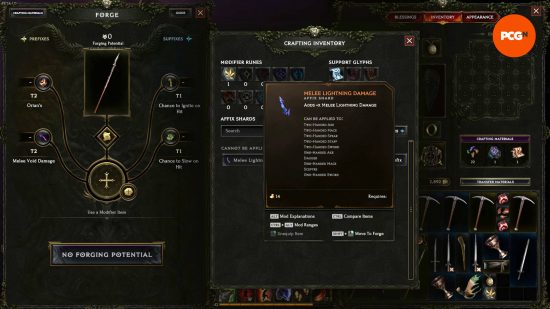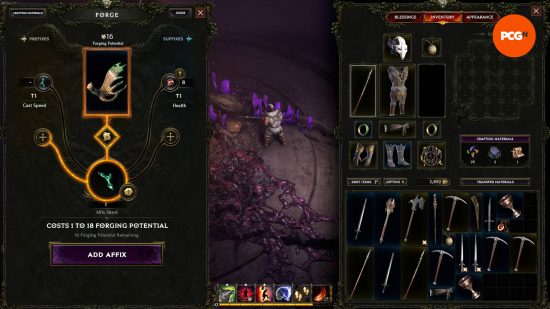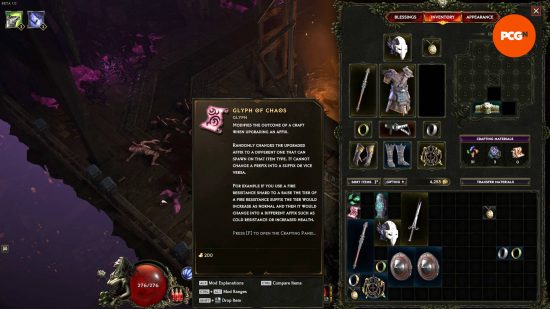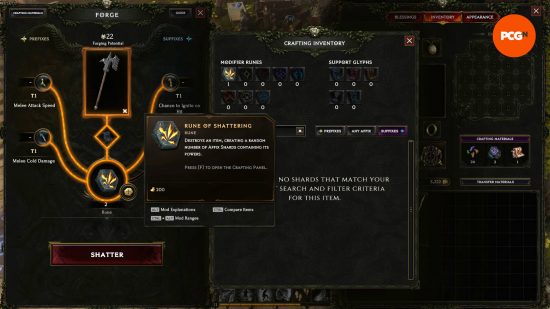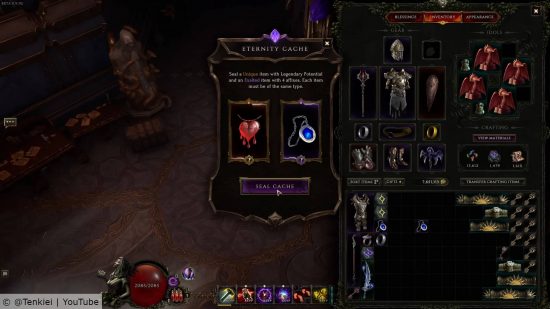How does Last Epoch crafting work? Making builds is at the core of this ARPG, as not only can your character level up and gain unique buffs, but each skill you equip can get points you spend to make it more potent. But having decent killing techniques is only part of the puzzle, as your equipment truly dictates precisely how powerful you really are. Luckily, you can mitigate the sheer random nature of this by taking advantage of crafting.
It may be tempting to just leave this whole mechanic until the endgame, but you should explore the Last Epoch crafting system as early as possible in the RPG game. Just be very careful about what you spend, as there are some glyphs and runes that are a little more complex, and that’s not even getting started on legendary items that require you to complete an endgame dungeon just for the privilege of using the Eternity Cache within. Here is everything you could possibly want to know about Last Epoch crafting to help you make the best Last Epoch builds.
Last Epoch crafting material locations
The three main Last Epoch crafting materials you can find on your journey are affixes, glyphs, and runes. Your main resources are the many affix shards your enemies will drop on the ground or found by smashing open barrels and other destructible objects. You’ll also have a rare chance of finding most of the glyphs and runes anywhere in the game, though Rune of Research tends to drop from Exiled Mages in the endgame.
How to use Last Epoch crafting items
Now that you’ve built up a collection of Last Epoch crafting items, it’s time to explain what they do. You can only craft on normal, magic, rare, or exalted items. Whenever you are crafting gear at the forge, it’s important to note that if the item has no Forging Potential left, you can’t add or subtract anything from that item. Your only option at this point is to sell it. It’s better to work on lower-tier affixes first, as the Forging Potential cost is cheaper.
An item has one or two set affixes, specifically a prefix and a suffix. These are the modifiers you see on items of magic or better rarity, and the higher the tier of affix, the greater the buff you’ll get. While you can only increase an affix tier to a maximum of five, there are items out there with tier six and above affixes pre-equipped, and they’re the ones you’ll want to upgrade.
You also have a chance to get critical success on any crafting you do in the forge. This will automatically increase any affixes you invest in by one for free. If you paid for a tier increase, you should see this go up by two.
Glyphs generally affect the crafting process when used and can be slotted into the Glyph slot no matter what the reason, provided you’ve collected enough of them. Runes are for more drastic modifications via unique effects and would take the slot of an affix shard.
In the early game, focus on increasing damage with your weapons, health and resistance with gear, and speed with your boots. This is because you’re likely to throw them away as you edge closer to the endgame. Stick to the strengths of your class when making these early game decisions, and you’ll be in a better position later on.
There are over 400 known affix shards, so far too many to list here, but if you’re curious, there is a database at Last Epoch tools with every single affix, including what they can be applied to and what prefix or suffix it gives you. Below is an at-a-glance summary of all the available glyphs and runes, with details on the best times to use them:
Glyphs
- Glyph of Hope: grants a 25% chance that this craft will have no forging potential cost. It’s best used whenever you’re upgrading an affix’s tier level.
- Glyph of Chaos: randomly changes the upgraded affix to a different one that can spawn on that item type. Will not change prefix into suffix or vice versa. You can use an upgrade roll to a new tier to randomly alter the affix to a different type, but this comes with a risk of the result being less than ideal.
- Glyph of Order: prevents the roll of an affix within its range from changing when it’s upgraded. This can be handy for increasing the percentage to trigger a higher fixed number.
- Glyph of Despair: has a chance to seal an affix instead of upgrading it. If so, it moves to a different, permanently locked slot and opens the old slot, ready to put in a new affix. This is more likely to work on low-tier affixes than higher ones.
- Glyph of Insight: changes a prefix into an experimental affix. This only works for gloves, boots, or belts. Generally, only try to do this when you’re close to finalizing your equipment. Experimental Affixes give two abilities at once.
Runes
- Rune of Shattering: destroys the item and creates a random number of the affix shards containing its powers. The shards you get back are usually less than those used on the item itself.
- Rune of Refinement: rerolls the values of all affixes on an item within their tiers. This can be helpful if there are incredibly low bonuses to any of your gear’s affixes.
- Rune of Removal: removes a random affix on an item, returning shards equal to its tier. If the shards themselves are the valuable commodity on an item, you’ll want to use this rather than Rune of Shattering. It can be combined with Glyph of Hope to reduce the effect on the Forging Potential.
- Rune of Discovery: adds a random tier 1 affix to all empty slots on an item, with an increased chance of rolling rarer affixes. This could be useful when combined with a Rune of Shattering afterward, but it’s generally easier to find them on the ground or during gameplay.
- Rune of Shaping: rerolls all implicits on an item. We think this is best used as the final step of crafting an item and only if there is a range. This will attempt to convert any ranges to a single figure.
- Rune of Ascendance: changes the item into a unique or set item of the same item type. This will change the item but not give you a like-for-like so that an imperial bow won’t change into another imperial bow, but it will become a different Rogue Bow class weapon. Uniques have no Forging Potential. Your previously equipped affixes will also disappear, so it’s best to use this with junk that is of the same item type you are hunting a unique for.
- Rune of Creation: duplicates an item but reduces the Forging Potential of both the original and its copy to zero. If you have a very valuable piece of gear you want to sell, high-quality items you want to turn into Legendary gear (more on that later), or just wish to dual-wield the same swords, this can be a great way to cheat in a copy. Use these extremely cautiously, as they’re very rare.
- Rune of Research: seals an experimental affix on the item into its own slot, allowing you to add a new affix to its old slot. This also has the potential of you gaining a Glyph of Insight, which is more likely with items of higher-tier affixes but can’t exceed a 45% chance.
How to craft legendary items in Last Epoch
The final thing to know about crafting is that you can make legendary items. To make a legendary item (red border), you need a Unique rarity item (orange border) that has “Legendary Potential”, which is shown underneath the item’s base stats, and an Exalted rarity item (purple border) of the same type with four affixes.
What this does is take one random affix from the Exalted item per Legendary Potential number and put it onto the Unique item to create a Legendary version. You’ll need to place them into the Eternity Cache at the end of the Temporal Sanctum dungeon. This is accessed via the Temporal Sanctum Key, which can drop randomly, but has a higher chance to appear after beating Timeline bosses in the Monolith of Fate. Proceed through the Sanctum and kill Julra to find the Eternity Cache.
You’ll now need to seal away your items. Use Temporal Shift if needed to go to the Divine Era and place your two items into the Eternity Cache. Seal it by clicking the button underneath, then use Temporal Shift to switch to the Ruined Era. You can now open the cache again to retrieve your new Legendary gear.
With that, you should know not only how Last Epoch crafting works but also how to make the very best legendary gear. It’s going to take some time for a new adventurer to get to the endgame stages where this mechanic really shines, so tinker around with it for a bit beforehand to get used to it.
In the meantime, if you find that this is not the ARPG for you, there are plenty of other games like Diablo to try instead. We also have a list of Last Epoch system requirements in case you need to upgrade your gaming rig.


